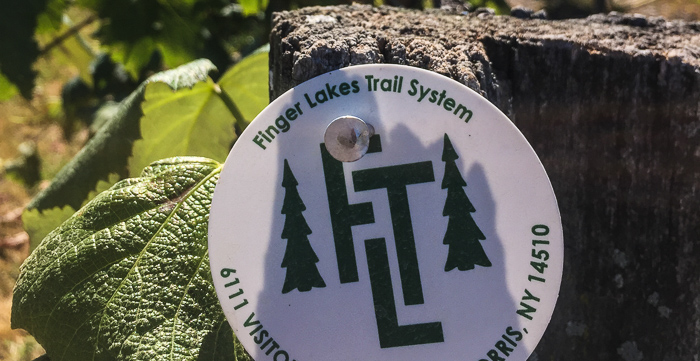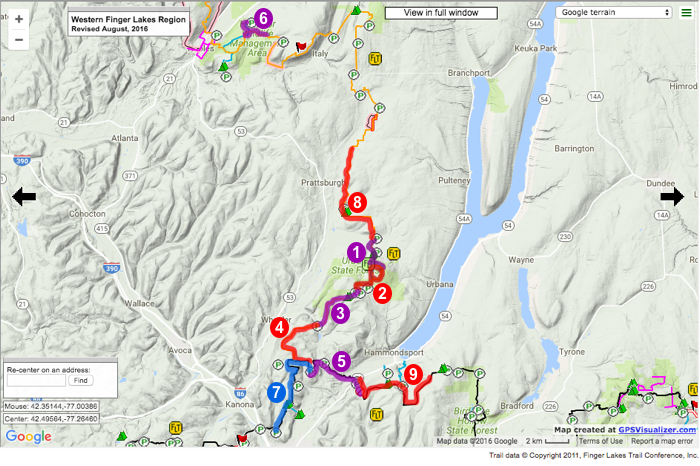Hiking the Finger Lakes Trail
Overview
I’ve been visiting Keuka Lake my entire life, but this is the first year I got out to hike trails. Why the change? Two reasons: 1) I stayed the whole summer so had more time; and 2) I needed to train for a 100-mile backpacking trip through Shenandoah National Park (woohoo!!).
I’m thrilled that I finally had a compelling reason to explore. The Finger Lakes region is quite stunning with rich farmland, lush vineyards, and pristine lakes sprinkled throughout its glacially carved hills and valleys. This area has always been one of my favorite places on earth and after walking serene forest paths, meeting deer and newt, and breathing in sweeping vistas, its #1 status is firmly cemented.
Though there are many trails in the region, I stuck firmly to the Finger Lakes Trail (FLT) system. The main trail of the FLT runs roughly east-west for 575 miles from the the Catskills to the Pennsylvania-New York border and passes right along the southern end of Keuka Lake just 15 minutes from our cottage. Even better, the FLT system has an additional 412 miles of branch and loop trails including the Bristol Hills Branch Trail that shoots north from the FLT and parallels Keuka’s west side – perfect!
I completed nine hikes the summer of 2016 and wrote a blog post for each, complete with narrative description, photos, map, elevation profile, and links to other helpful resources. Click on the “Map” tab for a complete list of articles along with an overview map highlighting my treks.
All hikes are not created equal and I certainly had a few favorites:
- The FLT from Sand Pit Road to Newton Road, especially the area near the Pucker Bush Overlook. Fantastic views!
- The Huckleberry Bog Loop on the Bristol Hills Trail. In this write-up we parked at Two Rod Road and hiked north, but your best bet is to park at Bean Station Road and hike south to the loop. Be sure to stop at the trail register box and pick up a Nature Trail Guide to carry along. Learn about flora, fauna, and a bit of area history, then return the guide when finished. Many thanks to the FLT Conference volunteers for this engaging guide!
- The Bristol Hills Trail from Mitchellsville Road to the FLT. This trek offered nice variety and burst out of the woods four times, first at the lovely Dave Lake.
Finally, my biggest lesson learned: Take breaks. On long hikes I’ve struggled with feet that feel bruised and sore, sometimes leaving me hobbling. I’ve come to the conclusion that the pain is due to swelling and rest is key. When I sit for 5–10 minutes every hour, my feet are rejuvenated, especially when I take boots off, massage the feet, and then re-lace looser. A cold stream would be a heavenly remedy, but not always available!
Map
I explored nine sections of the Finger Lakes Trail system in the summer of 2016, listed below in hiking order. The numbers correlate to those on the map below. Click on each title for hike description, photos, map, and elevation profile.
- Training for the A.T. on the Finger Lakes Trail System: The Bristol Hills Branch Trail from Elmboise Rd. to Bog Spur (2.5 miles one way; 5 miles total)
- Hiking the Bristol Hills Trail: Two Rod Road to the Huckleberry Bog Loop (6.2 mile loop)
- Hiking the Bristol Hills Trail: Two Rod Road to Mitchellsville Road (3.6 miles one way; 7.2 miles total)
- Hiking the Bristol Hills Trail: Mitchellsville Road to the FLT (4.0 miles one way; 8.0 miles total)
- Hiking the Finger Lakes Trail: Mitchellsville Gorge (4.6 miles one way; 9.2 miles total). The most scenic section of this trail is just 2.5 miles one way, so a 5-mile round trip hike.
- Chased off the Hi Tor Blue Trail! We had to cut this hike short due to deer flies - what a menace!
- Hiking the Finger Lakes Trail: Sand Pit Road to Newton Road (6.15 miles one way; 12.3 miles total)
- Hiking the Bristol Hills Trail: Elmboise Road to Patch Road (6.5 miles one way; 13 miles total)
- Hiking the Finger Lakes Trail: Route 54 to Longwell Road (7.1 miles one way; 14.2 miles total)
The parking spot for each hike is noted with a green pin in the Google map below. The other pins highlight sightseeing and other activities in the area, as described in the Summers at Keuka Lake trip summary . If a location is pinned it has been mentioned in a blog post. To easily locate a specific article, use Plan-Pack-Go’s “Search this website…” function. For example, the Glenn H. Curtiss Museum has a pin. To find that write-up, type “Curtiss Museum” into the search bar and any article mentioning the museum will pop up.
Preparation
I used two main websites for pre-hike trail information:
- The Finger Lake Trail Conference website has a handy interactive map with designated parking areas. It also provides up-to-date trail conditions.
- CNY hiking offers detailed mile-by-mile trail descriptions for hikes in central and upstate New York including the Bristol Hills Trail and the Finger Lakes Trail.
Sadly I felt compelled to write A Beginner’s Guide to Hiking in the Finger Lakes During Deer Fly Season after being driven off the Hi Tor Blue Trail. If you’ve ever been the victim of a horde of deer flies you feel my pain – they’re a buzzing, biting menace!
Packing List
Whether day-hiking or camping overnight, always carry the 10 essentials:
- Navigation equipment: Map, compass, and/or smart phone.
- Water
- Extra food
- Extra clothing: Including weatherproof outer layer
- Light source: Headlamp or flashlight
- First aid supplies: Bandaids, moelskin, OTC pain meds…
- Knife or multi-tool
- Sun protection: Sunscreen and hat or sunglasses
- Fire supplies: Lighter or waterproof matches
- Emergency shelter: I carry a lightweight thermal blanket
A also appreciated:
- A bandana
- Cash and ID: This should be a no-brainer, but I left both in my car for the first six hikes.
- Long pants: The one time I wore shorts, I broke out in a rash after walking through tall grasses.
- Waterproof boots: I’ve come full circle having started out hiking in boots years ago, then transitioned to light hikers, then mesh-top running shoes, and now back to boots. Why back to boots? The sturdy sole, and my feet stay bone dry every time.
- Bug spray with DEET: Biting critters were often out in force, especially on hikes with standing water.
- Clothing and gear coated with Permethrin: I learned this trick after our ill-fated deer fly incident. Permethrin is an insect-killing repellant that is effective against ticks, chiggers, deer flies, and mosquitoes (amongst others). Just spray onto clothes and gear, let dry, and gain extra protection for up to 6 weeks or 6 washings.
- Gaiters: I had one too many hikes through mud or tall, damp grasses; knee-high waterproof gaiters would have been a welcome barrier to keep pants clean and dry. It’s important to note that on very hot days, gaiters can trap heat leaving the pants underneath soaked from sweat!

